This Biscoff Cookie Butter Cake is a showstopper that is sure to satisfy any sweet tooth. Moist, tender cake layers infused with Biscoff cookie butter spread, chunks of Lotus Biscoff cookies, and a Biscoff buttercream frosting take center stage in this cookie butter lover’s dream cake!
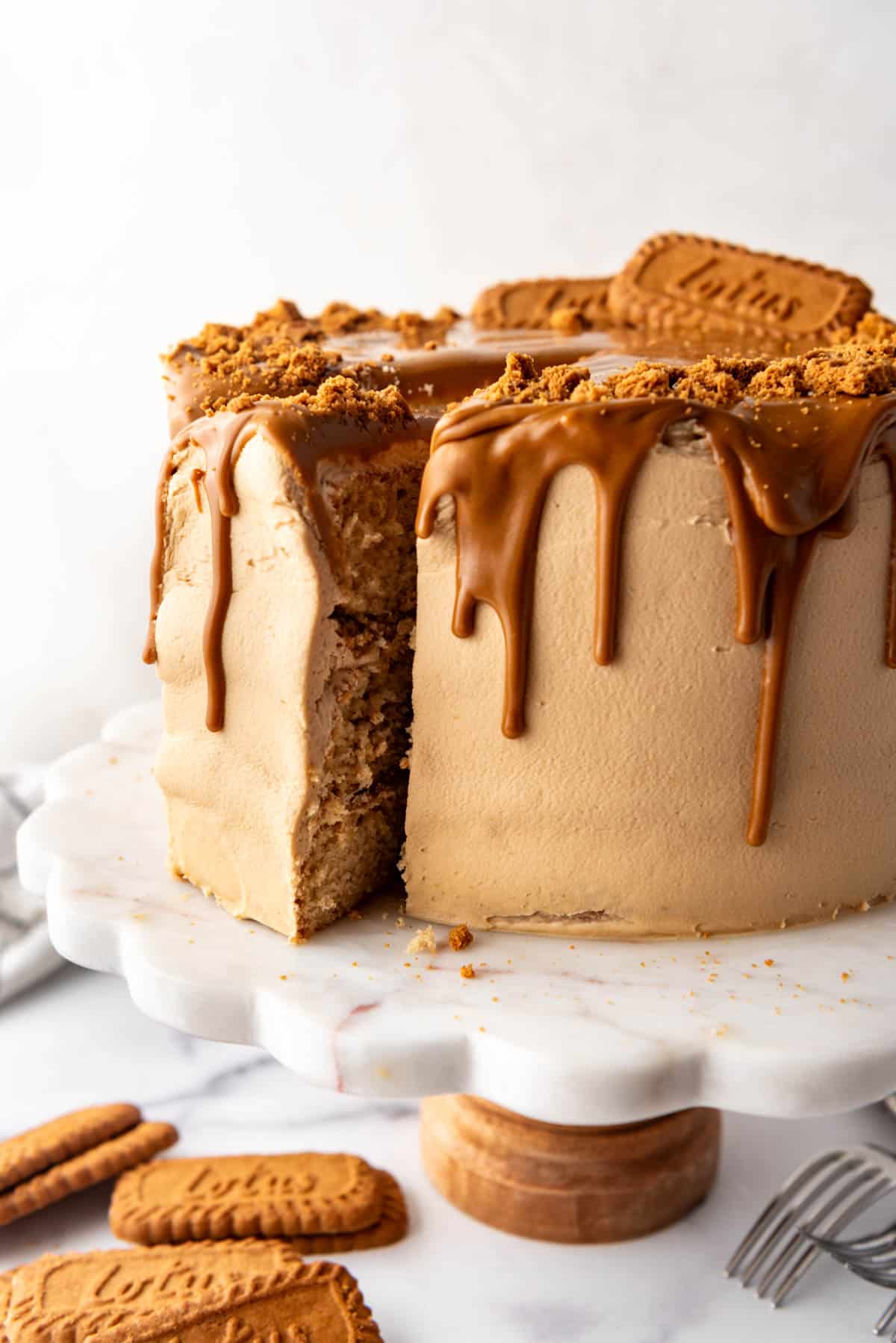
The plush, soft layers of cookie butter cake in this cake recipe are made from-scratch then stacked with pure cookie butter drizzle and a to-die-for cookie butter buttercream frosting for an unparalleled dessert experience. It’s based off my favorite vanilla cake recipe (which I still haven’t shared in it’s purest form!) and an absolute joy to bake.
Although there are a few steps to making the cake layers, frosting, and assembling, none of it is complicated. Just read through the recipe first and give yourself time for the cake layers to cool. You can even bake them a day ahead or even more and freeze the layers until you are ready to assemble.
If you love cookie butter like we do, don’t miss our Biscoff Cookie Butter White Chocolate Chip Cookies and our Cookie Butter Rice Krispie Treats.
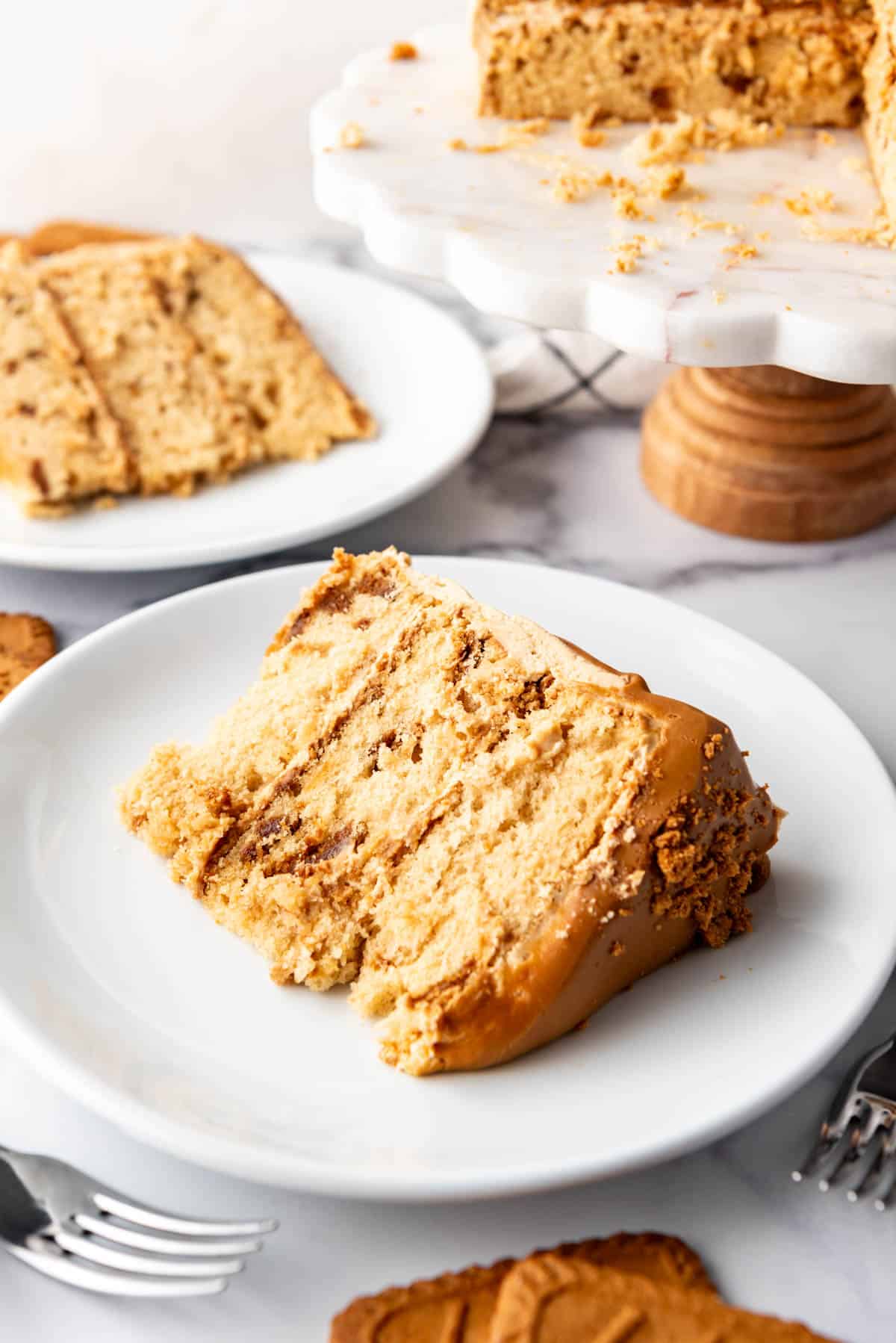
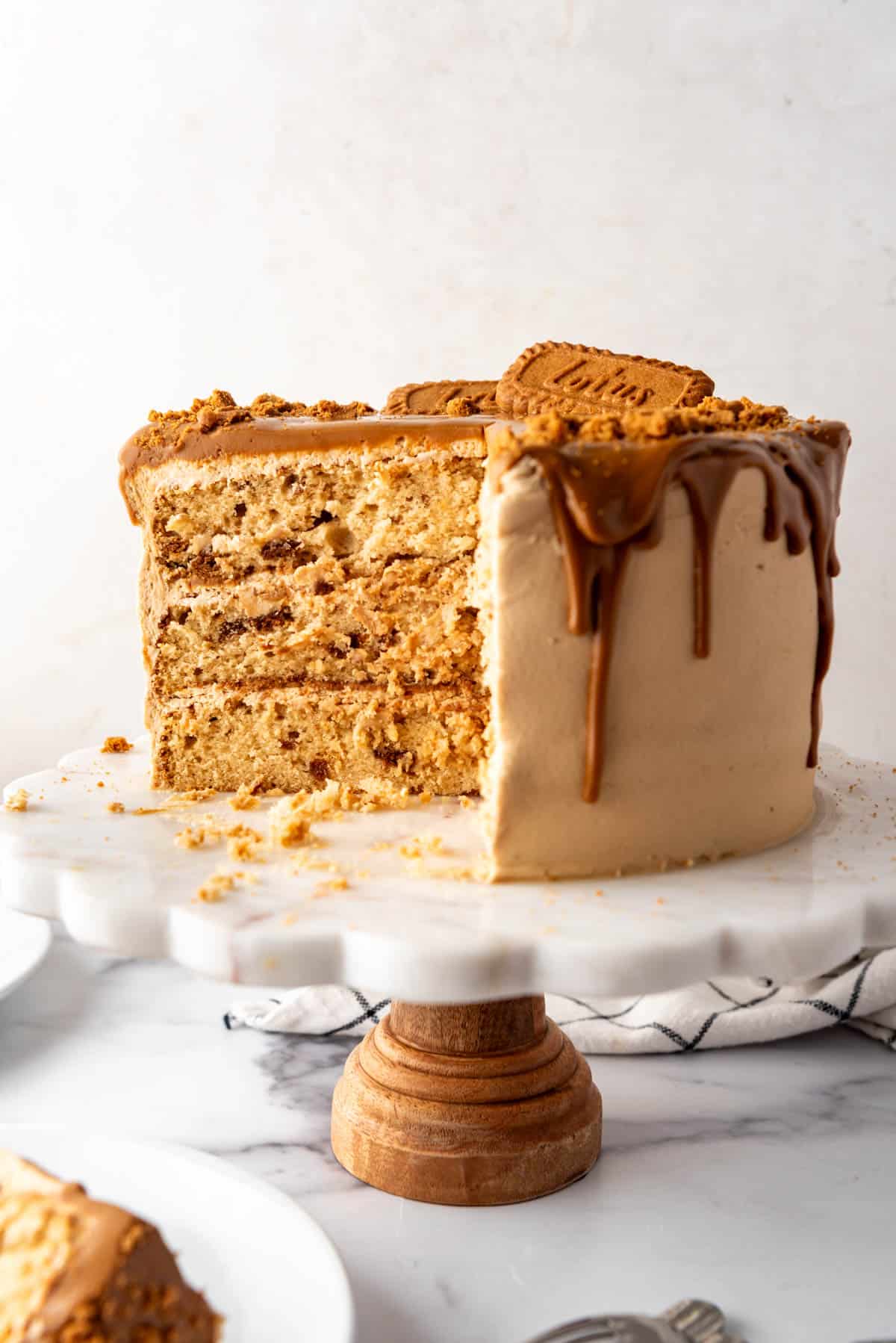
Gather Your Ingredients
Make sure you have all your ingredients at the ready for a stress-free baking day!
- Creamy cookie butter – You need 2 full jars of cookie butter for this recipe. Crunchy cookie butter might work, but I haven’t tried it yet myself.
- Lotus Biscoff cookies – You’ll need these for stirring into the cake batter as well as decorating the top of the cake.
- Egg whites – I like using egg whites for this recipe instead of whole eggs because they give a nicer color to the cake batter, but three whole eggs can be used in place of the egg whites.
- Salted butter & oil – I know lots of cake recipes only use unsalted butter, but I never keep it on hand, so I use salted butter for all my bakes. If you are using unsalted butter, just add an extra ¼ teaspoon of salt for each stick of butter. I also prefer a blend of butter (for best flavor) with oil (for keeping the cake extra moist).
- Sugar – Granulated sugar sweetens the cake layers and powdered sugar is the base of the buttercream frosting.
- Sour cream & milk – These ingredients should be at room temperature for best results. It helps the batter mix together and bake more evenly so you don’t have domed tops to your cake layers.
- Cake flour – Gives the softest, lightest crumb to the cake. You can use all-purpose flour instead and the cake will turn out good, but cake flour makes a better cake if you can get some from the store.
- Baking powder, baking soda, and salt – Typical baking ingredients for leavening and flavor.
- Vanilla extract – This important ingredient balances all of the other flavors and adds dimension to your bake. I love using my homemade vanilla extract.
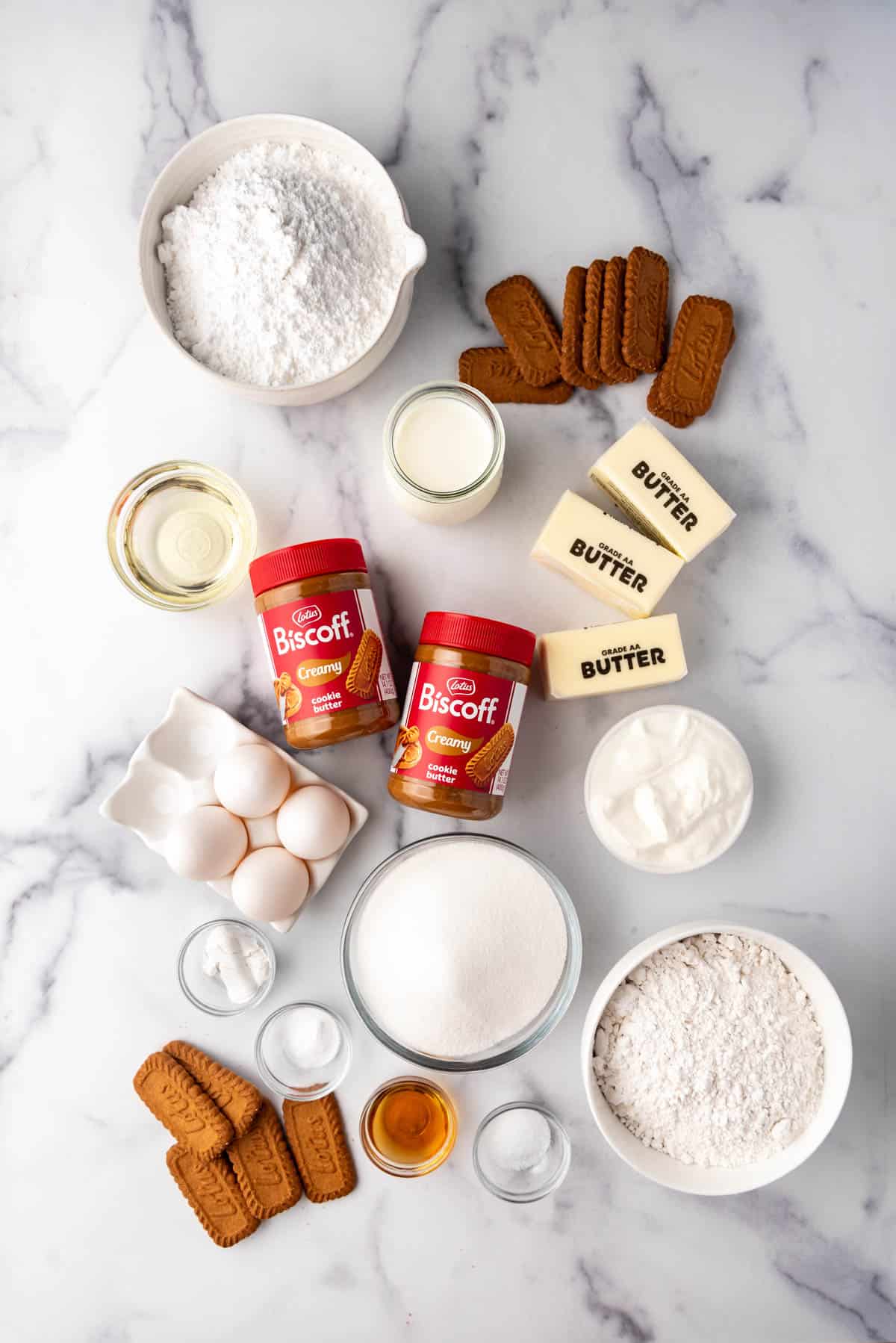
Step-by-Step Overview
This is to help you visualize the process. Please see the printable recipe card below for a printable version with full measurements and instructions.
- Cream butter, cookie butter, and sugar. Beat them well for 2-3 minutes until creamy and combined.
- Add oil, egg whites, and vanilla extract. Beat again until smooth and light, about 1-2 minutes.
- Add half of the dry ingredients. I like to alternate adding the flour with the milk and sour cream. I have found that by adding half of the flour along with all of the baking powder, baking soda, and salt, I can skip sifting or whisking the dry ingredients together because they all get evenly mixed in by the end. Mix just until the dry ingredients are mostly combined, but don’t overmix.
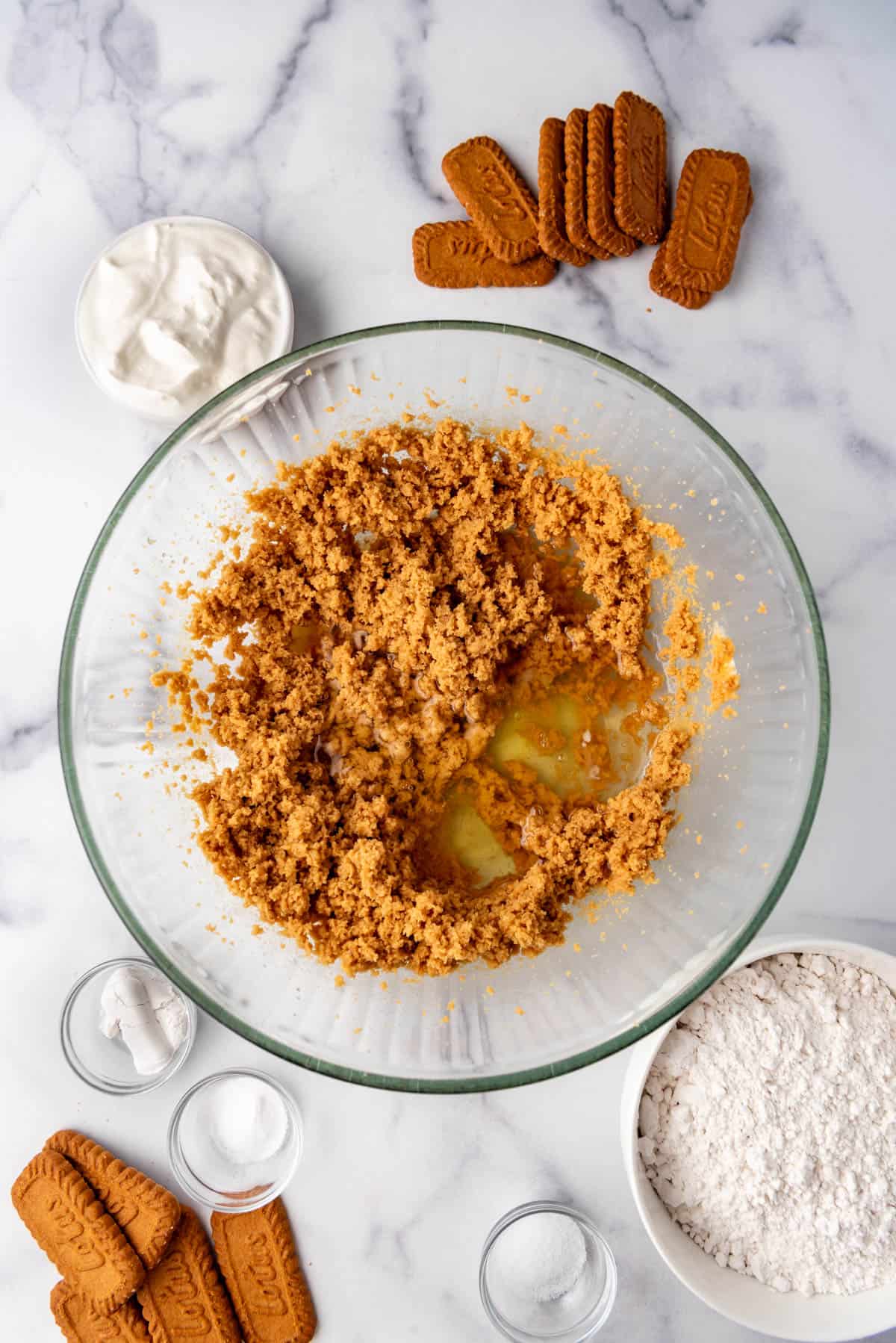
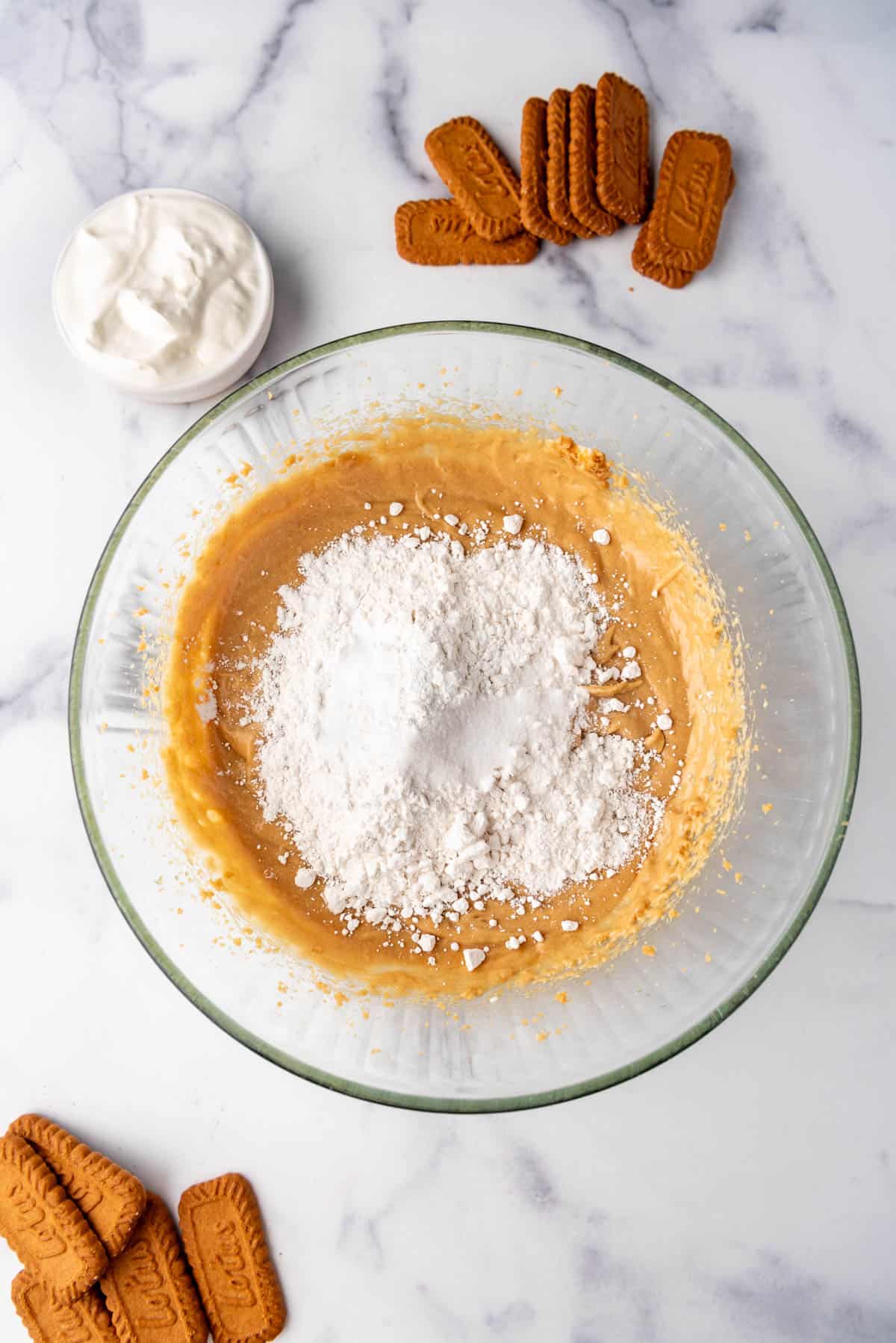
- Alternate adding wet ingredients. Add half of the milk and sour cream, mixing again until combined. Repeat with the remaining flour, followed by the last of the milk and sour cream. Scrape the bowl with a spatula to make sure everything gets evenly mixed together and don’t overmix the batter.
- Add crushed Biscoff cookies. Use a spatula to stir in some broken up Biscoff cookies by hand. I just break them apart with my fingers as I add them so that there are chunks of Biscoff throughout the batter.
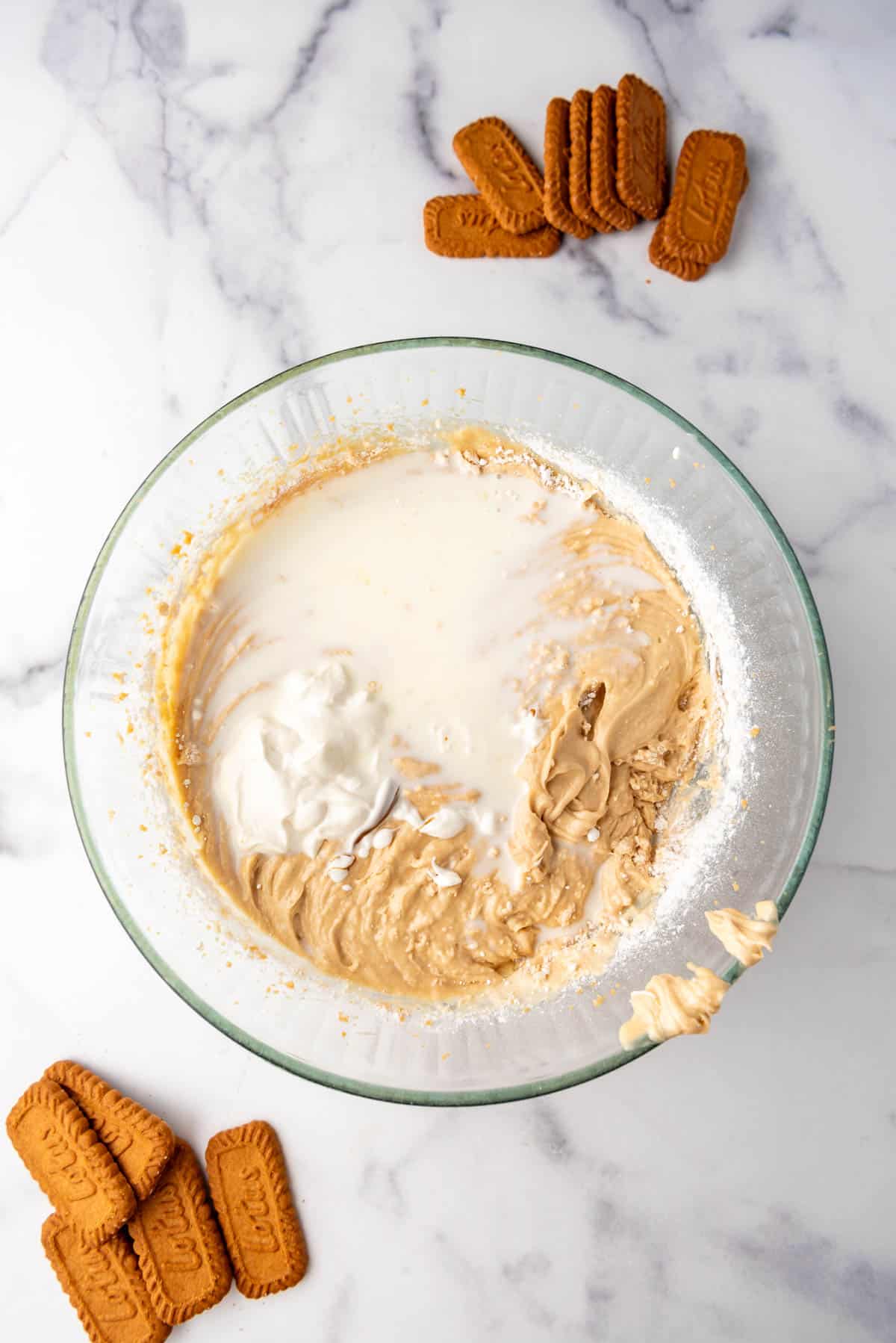
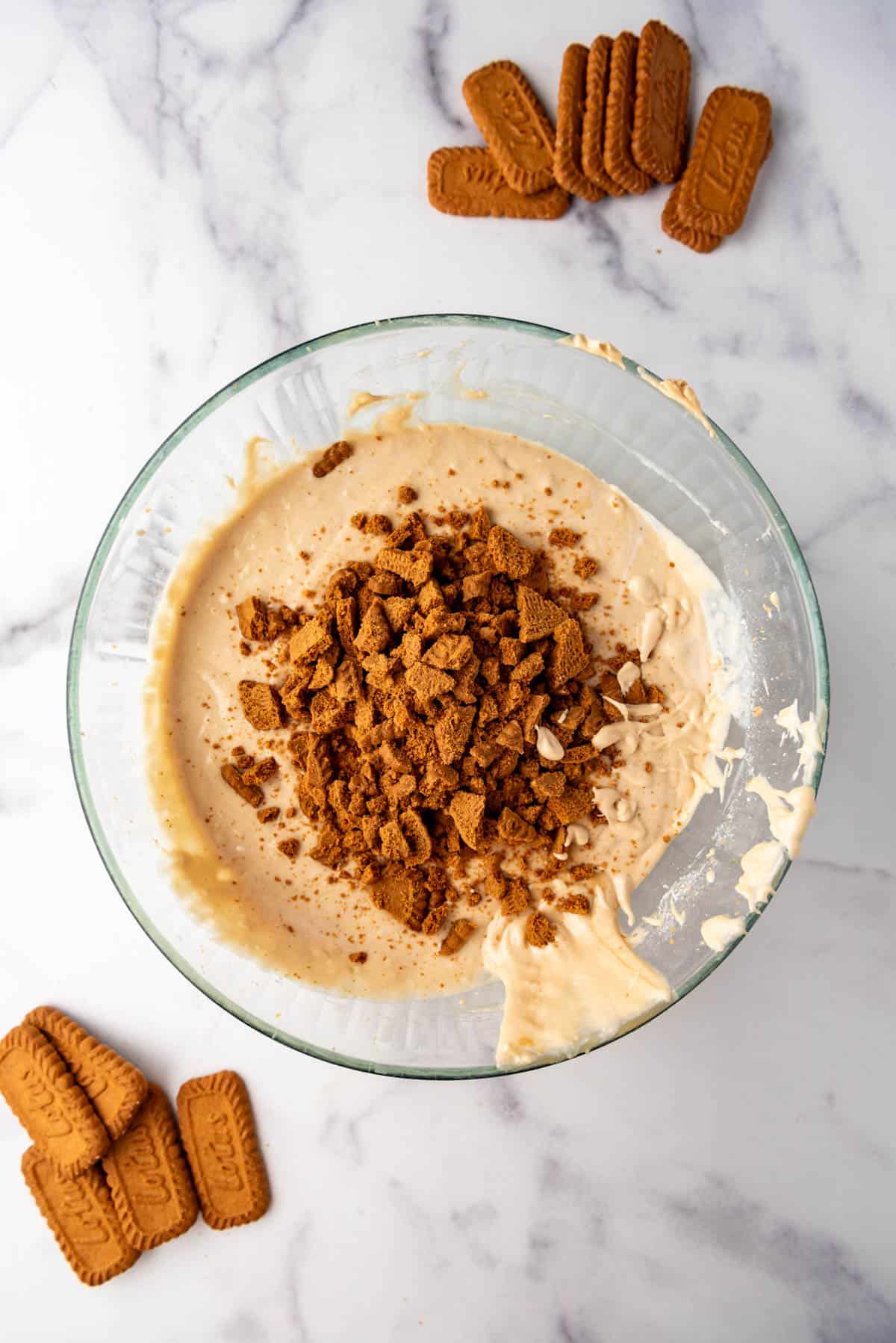
- Divide into three 8-inch pans. You can eyeball this or be precise and use a kitchen scale to make sure you have the exact same amount in each pan. I prep my pans with circles of parchment paper on the bottom and spraying them with baking spray so they don’t stick. See the recipe notes for variations on pan sizes.
- Bake. Pop the cake layers in the oven and bake for 23 to 28 minutes or until a toothpick or wooden skewer comes out clean with just a few crumbs clinging to it when stuck into the center of each layer.
- Cool. Let the cakes cool for 10 minutes in the pans before turning them out onto a wire cooling rack to cool the rest of the way before assembling. You can wrap the cooled layers in plastic wrap and freeze for up to 2 months at this point.
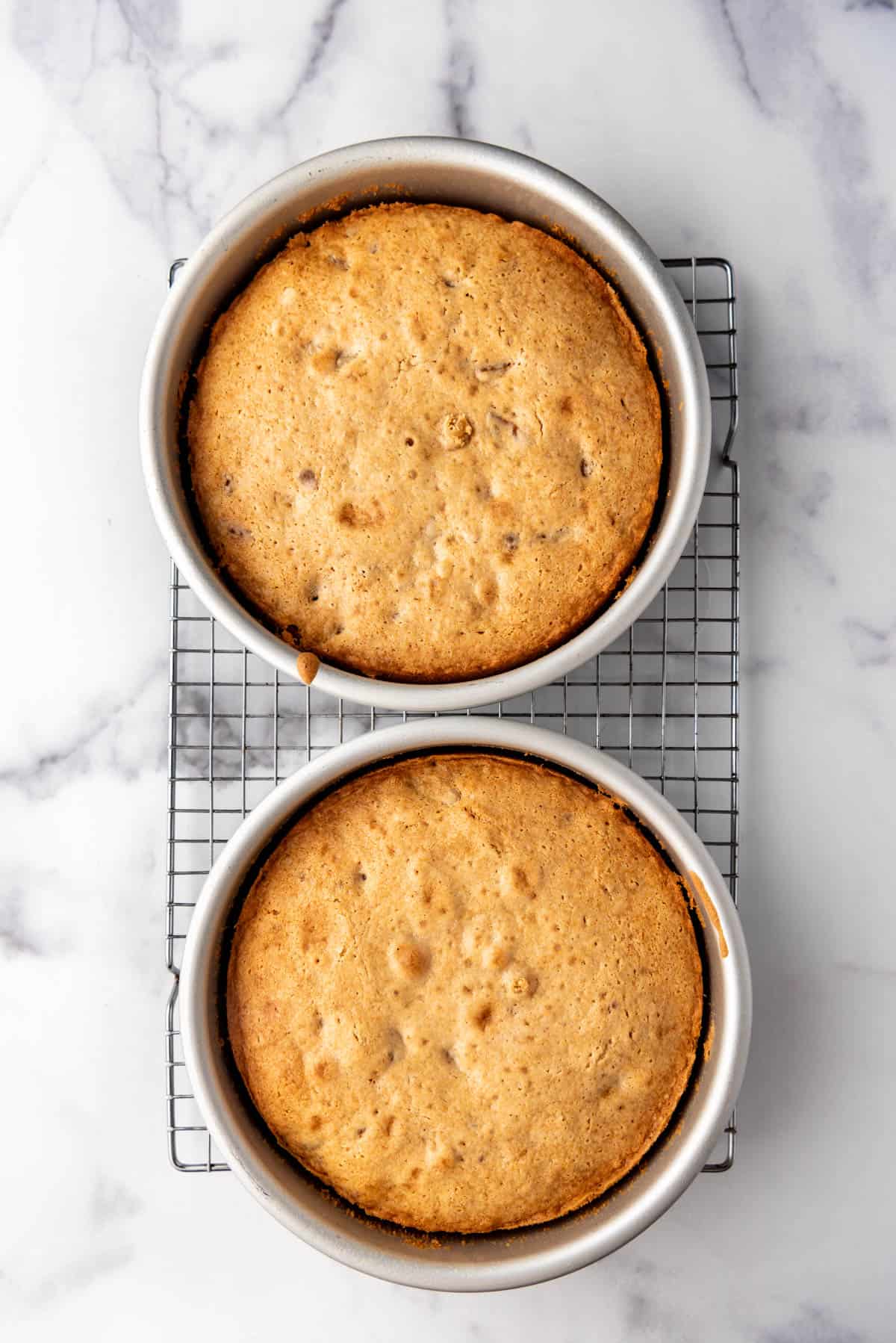
- Make the frosting. Cream softened butter and cookie butter in a large mixing bowl until smooth, then add the powdered sugar, heavy cream, and vanilla extract. Beat until nice and fluffy, then stir with a stiff spatula or wooden spoon to knock out some of the air bubbles in the frosting.
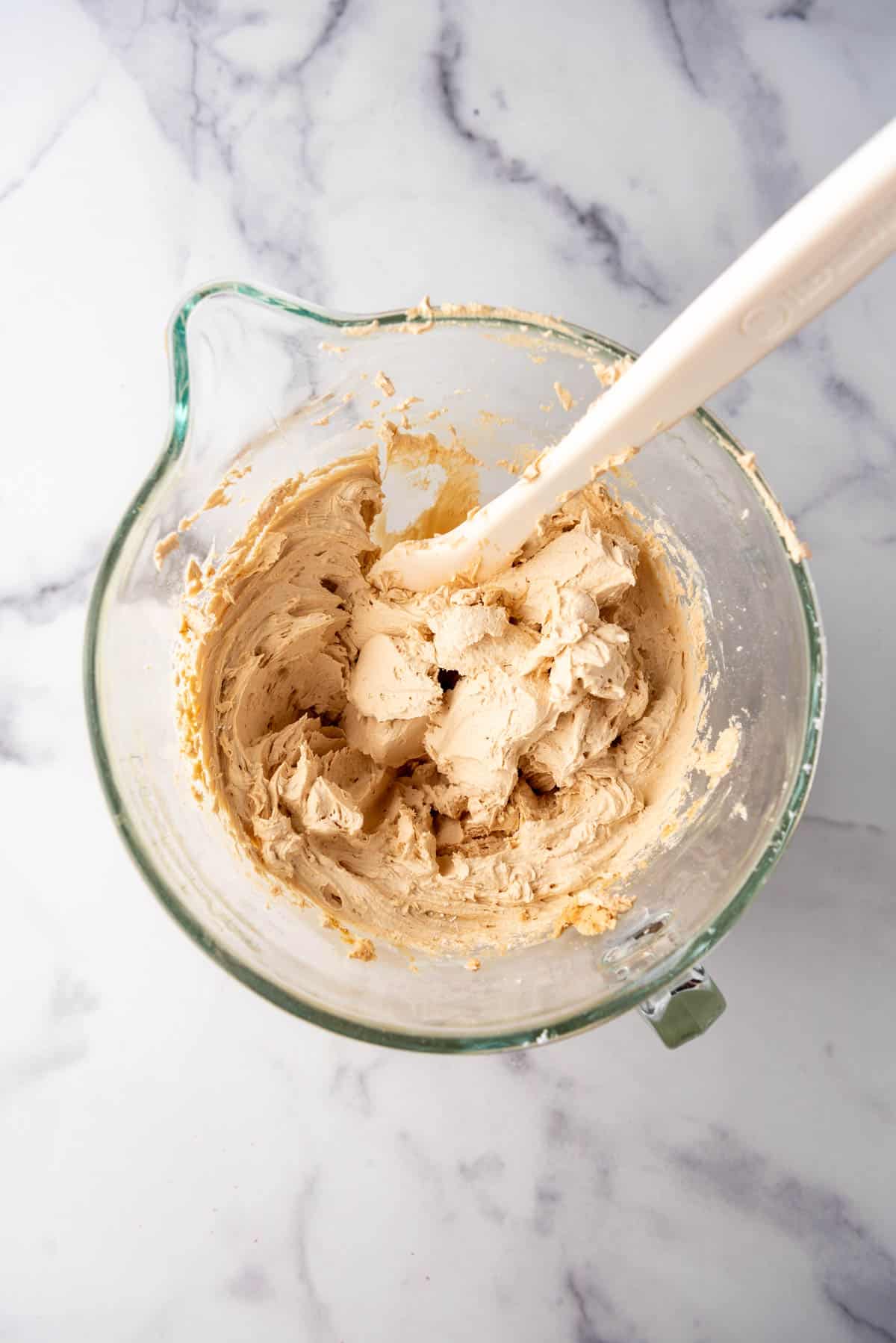
- Assemble! Now for the fun part. Place your first cake layer on a cake plate and cover with about ¾ cup of the frosting. Melt ½ cup of the cookie butter in the microwave just until it is pourable but not too hot. Drizzle over the frosting, then top with the second layer of cake and repeat with more frosting and cookie butter. Add the final layer and do a thin crumb coat to seal in any crumbs.
- Freeze. I highly recommend sticking the entire cake in the freezer for 30 minutes to set the crumb coat and help stabilize the cake (the melted Biscoff cookie butter can make the cake layers a little more slidey than your typical cake).
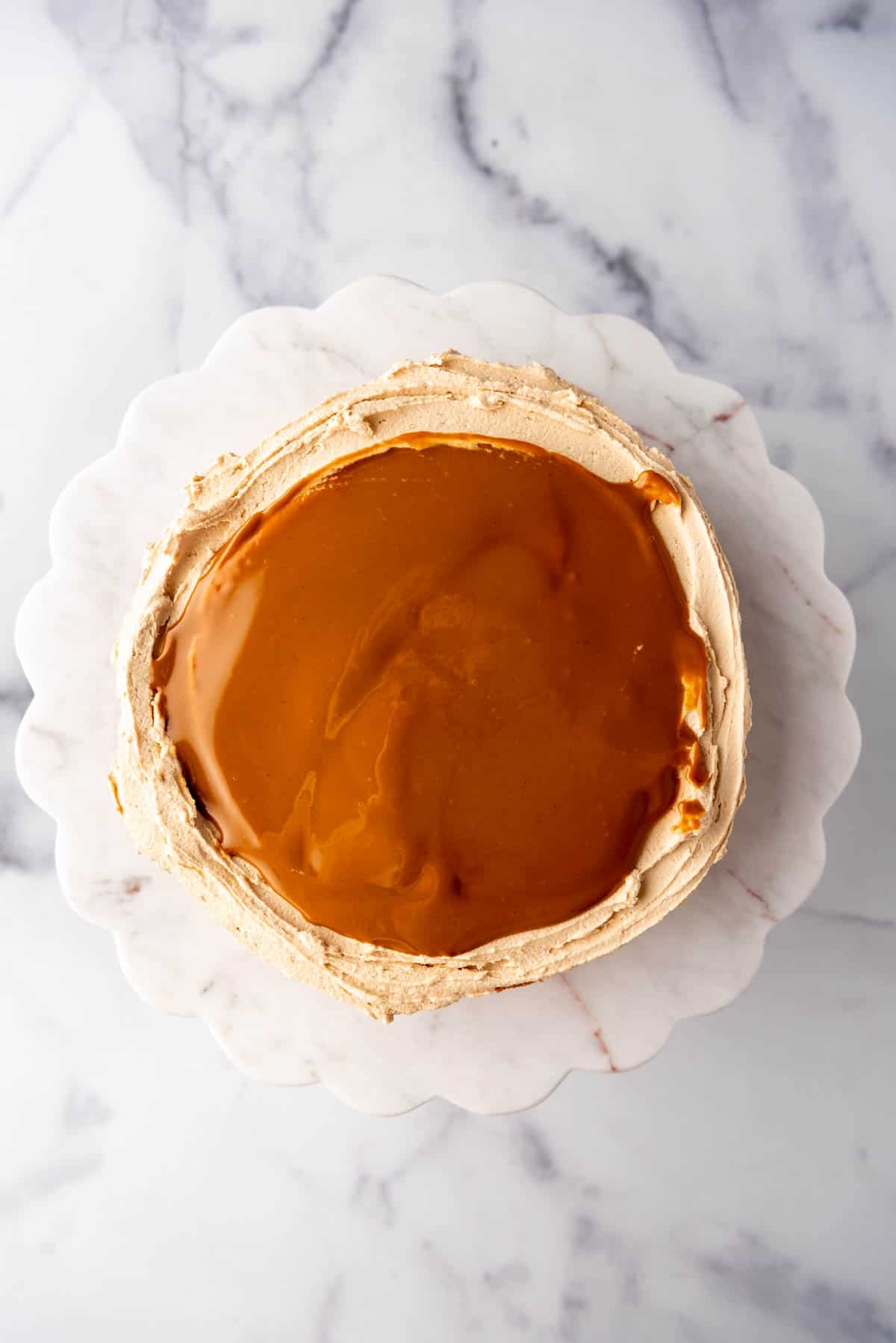
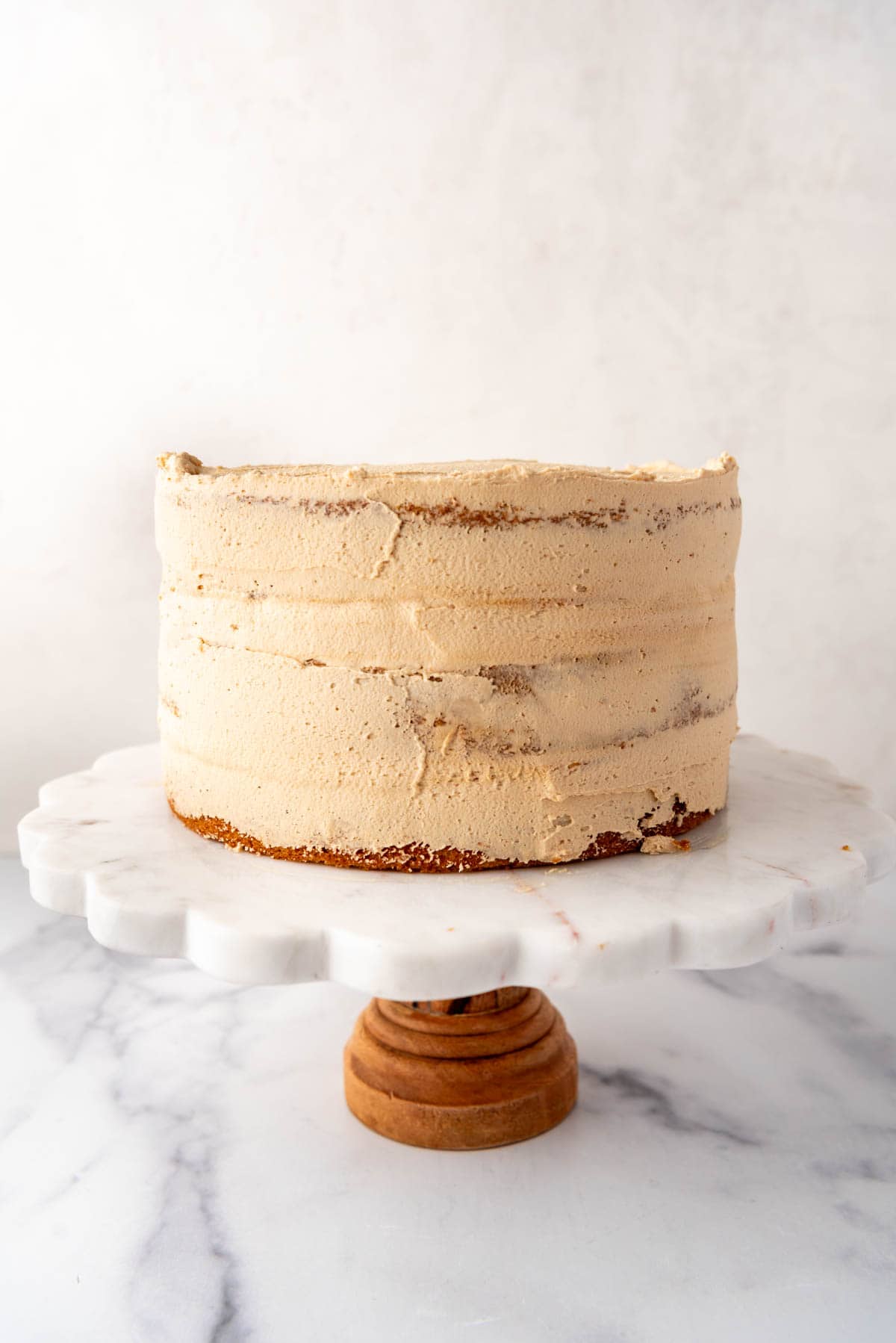
- Frost. Once the frosting is chilled and firm on the outside, finish frosting with the remaining frosting. If you want to have enough frosting to pipe swirls around the top, you will want to 1.5x the frosting recipe. Otherwise, I like to just pour a little more melted cookie butter over the top of the cake and sprinkle a few extra crushed Biscoff cookies around the rim for a top border. You can even nudge your cookie butter over the sides of the cake for a drip effect, if you like. It’s rustic and simple, but effective.
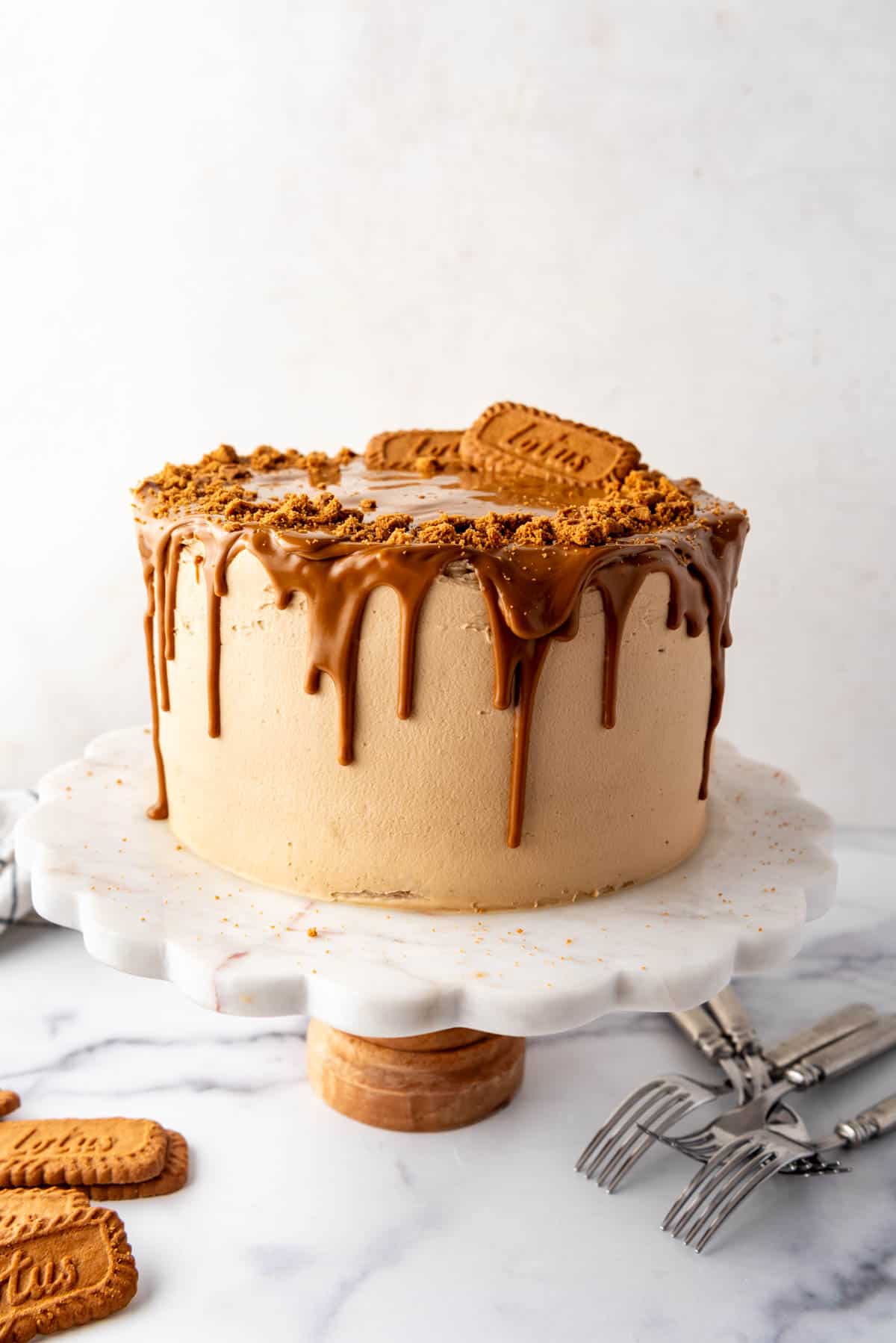
Recipe FAQ’s
I don’t know of a gluten-free cookie butter substitute, so unfortunately, no. At least not easily without making homemade gluten-free biscoff cookies and then turning them into cookie butter yourself.
If you want to use something other than an American buttercream, I would recommend a Swiss meringue buttercream with the cookie butter added in. It’s a little silkier, a little less sweet, and you just might decide you like it even better.
My regular grocery store sells this right next to the peanut butter and Nutella. But you can also use the Trader Joe’s Speculoos Cookie Butter if you can’t find the Biscoff spread.

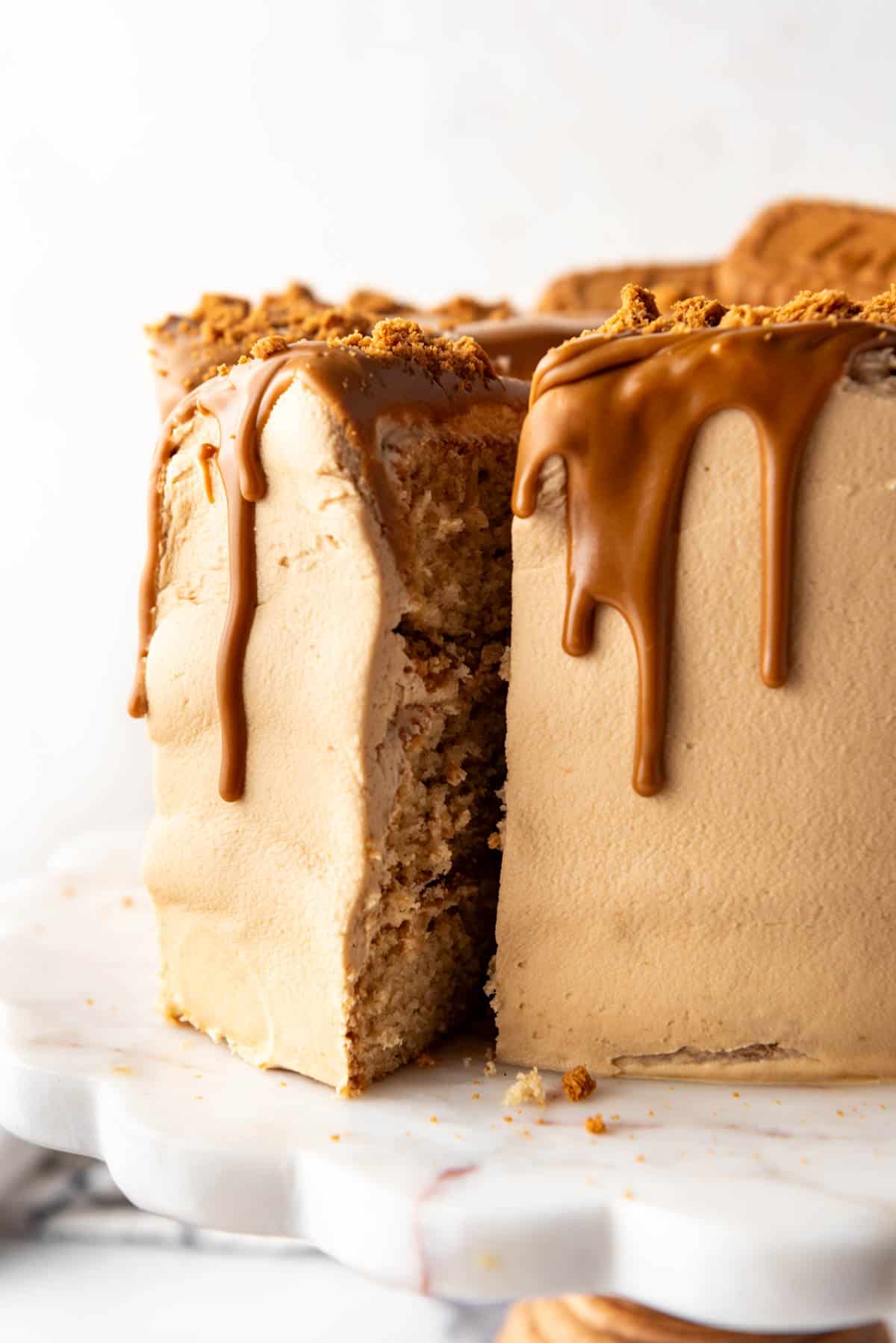
Storage & Freezing Instructions
- Storing: Store the finished cake at room temperature for 3-5 days in a covered, airtight container. If you slice into it, I recommend covering any exposed cake area with plastic wrap so it doesn’t dry out. I don’t recommend refrigerating cakes because it tends to make them taste stale faster.
- Freezing: You can freeze the whole cake for up to 3 months. Just cover it really well with plastic wrap, then foil to protect it in the freezer. It will need to thaw on the counter overnight to be ready to serve. You can also freeze individual slices so you can enjoy one whenever the craving strikes!
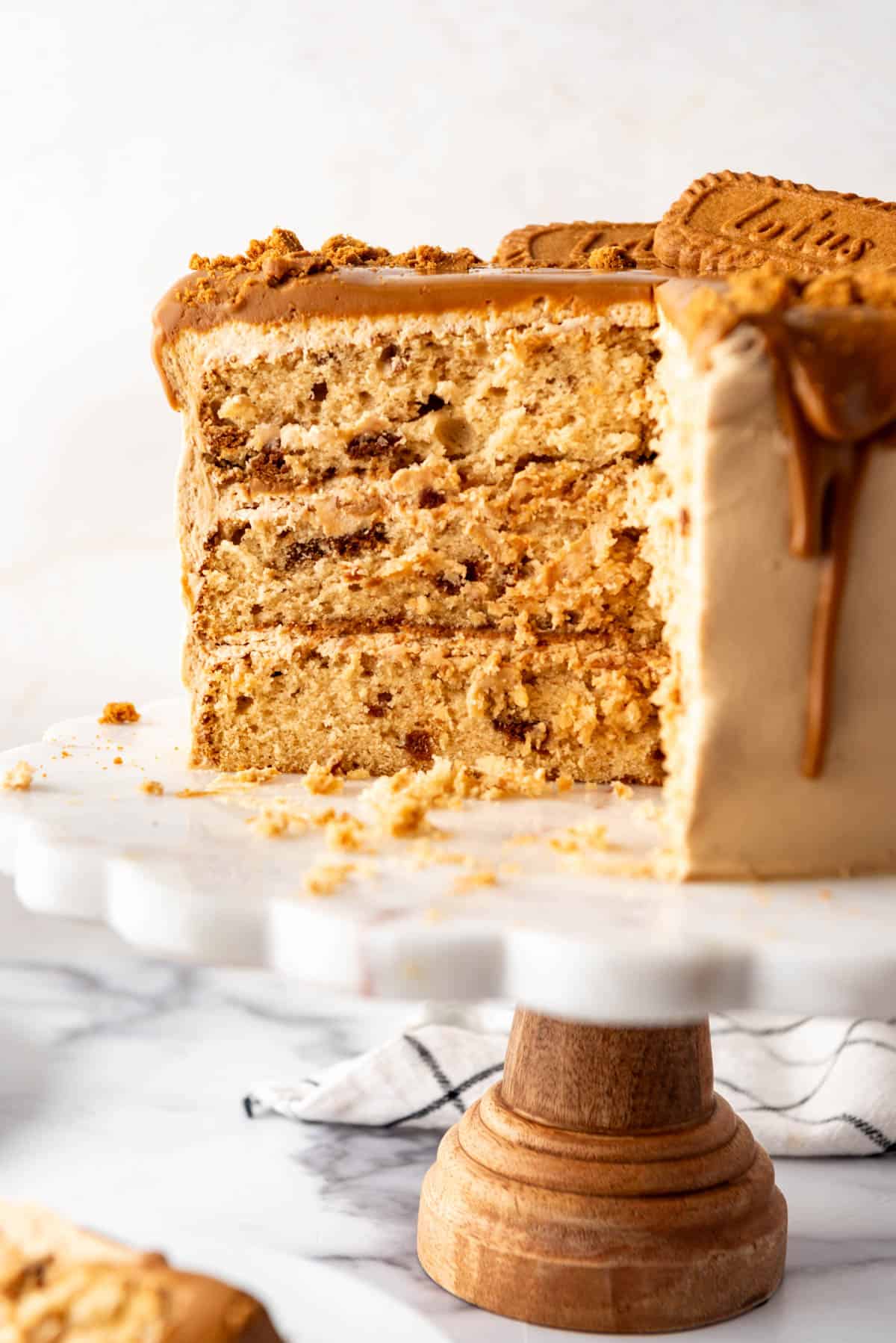
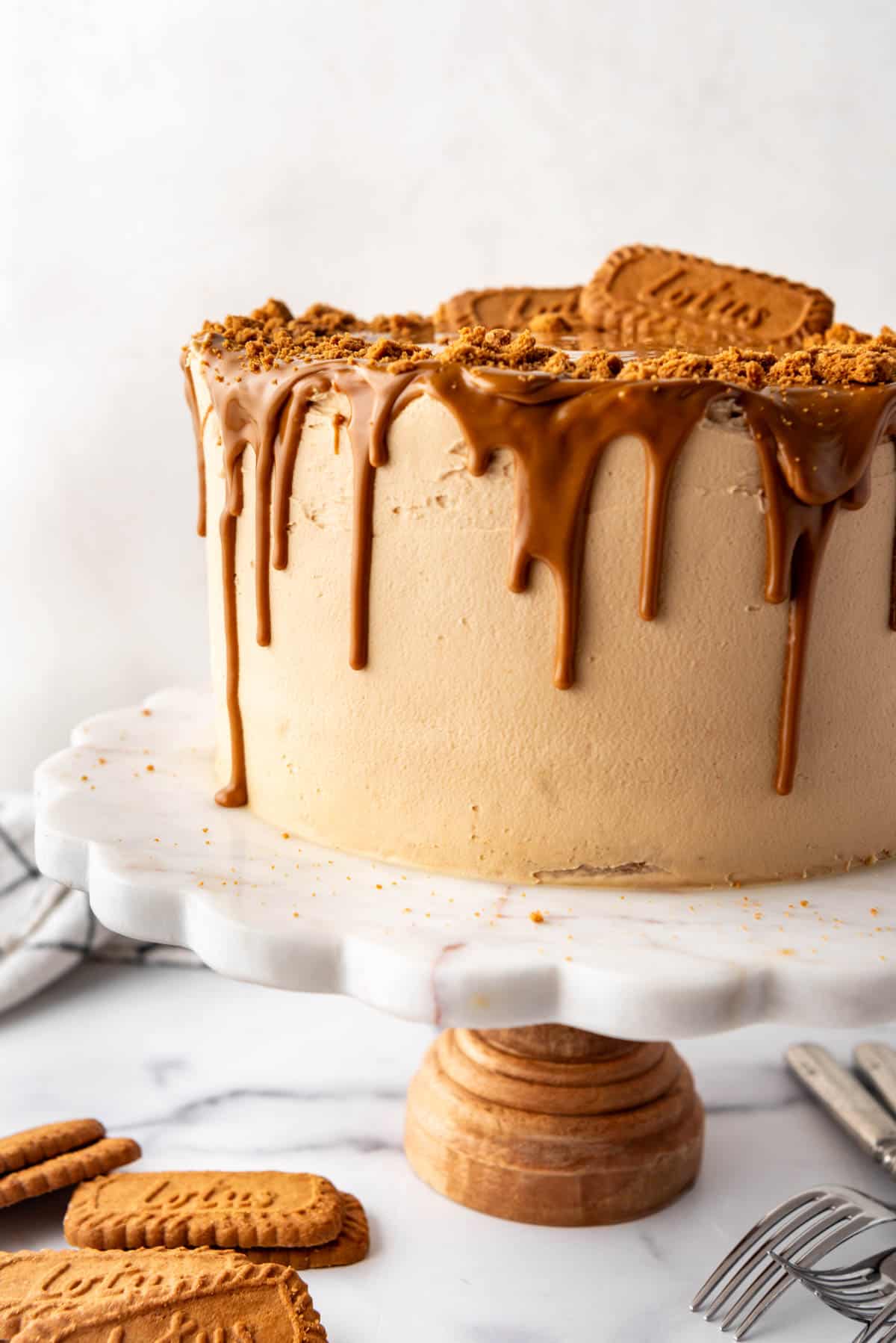
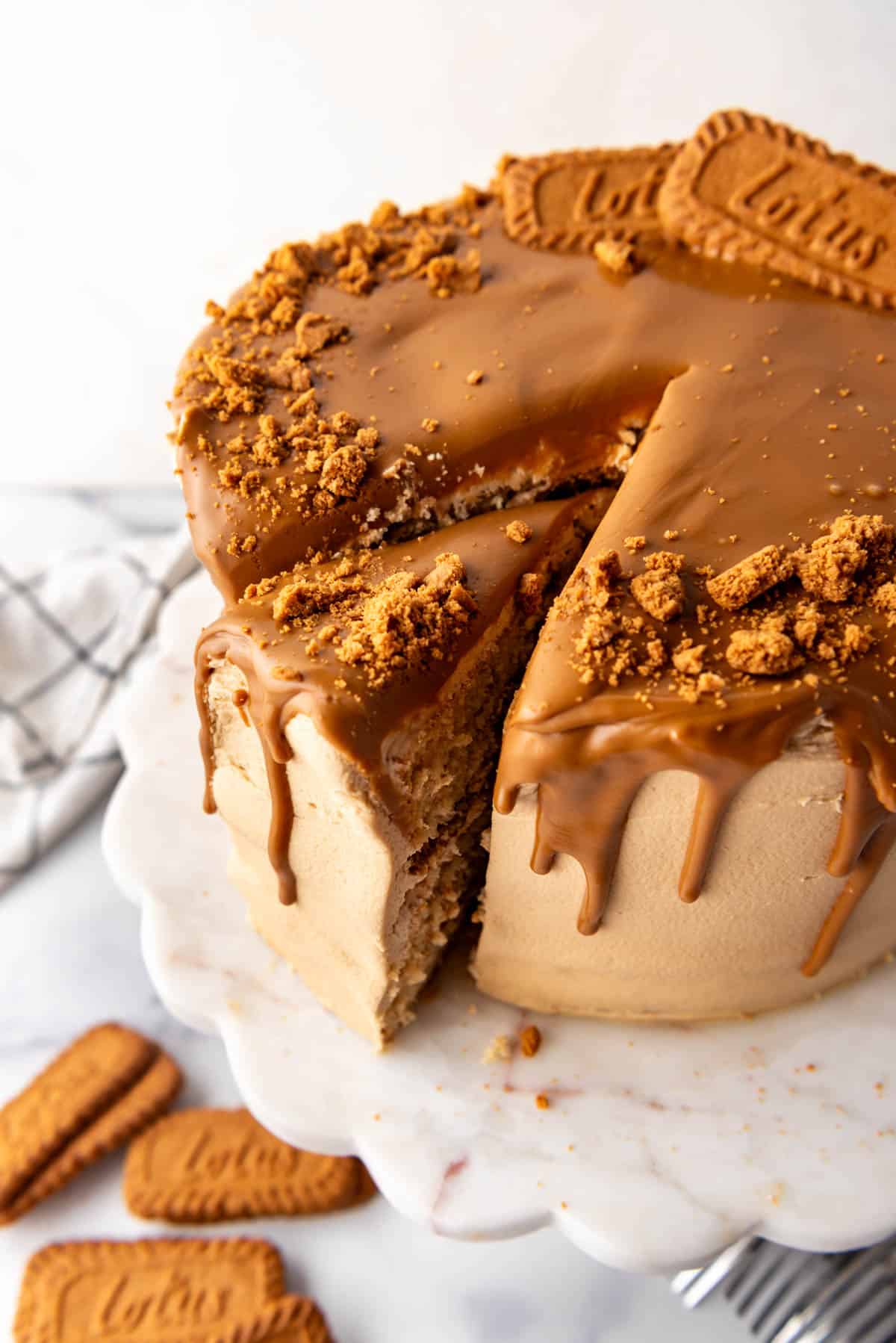
More Cake Recipes
Biscoff Cake Recipe
Ingredients
Cake Batter
- 1/2 cup salted butter softened
- 1/2 cup (140g) cookie butter
- 1 3/4 cup (350g) granulated sugar
- 1/4 cup vegetable oil
- 4 egg whites room temperature
- 2 teaspoon pure vanilla extract
- 2 2/3 cups (317g) cake flour
- 2 teaspoons baking powder
- 1/2 teaspoon baking soda
- 1/2 teaspoon salt
- 3/4 cup whole milk room temperature
- 3/4 cup sour cream room temperature
- 14 Biscoff cookies roughly broken into pieces (about 1 ¼ cups)
Biscoff Buttercream
- 1 cups salted butter softened
- 3/4 cup (210g) cookie butter
- 4 cups powdered sugar
- 1-2 Tablespoons heavy cream
- 1 teaspoon pure vanilla extract
Assembly
- 3/4 cup (210g) cookie butter melted and cooled slightly, divided
- 4-6 Biscoff cookies crushed for decorating
Instructions
- Preheat the oven to 350°F. Line three 8-inch cake pans with parchment paper circles on the bottom. Spray with baking spray.
- In a large mixing bowl, beat the butter, cookie butter, and sugar for 2-3 minutes until combined. Add oil, egg whites, and vanilla. Beat again until creamy and smooth.½ cup salted butter, ½ cup (140g) cookie butter, 1 ¾ cup (350g) granulated sugar, ¼ cup vegetable oil, 4 egg whites, 2 teaspoon pure vanilla extract
- Add half of the flour along with all of the baking powder, baking soda, and salt. Mix just until combined. Add half of the milk and sour cream. Mix again, stopping to scrape the bottom and sides of the bowl. Repeat with the remaining flour, milk, and sour cream.2 2/3 cups (317g) cake flour, 2 teaspoons baking powder, ½ teaspoon baking soda, ½ teaspoon salt, ¾ cup whole milk, ¾ cup sour cream
- Stir in the broken Biscoff cookies. Evenly divide the batter between the three prepared pans.14 Biscoff cookies
- Bake at 350°F for 23-28 minutes. Remove from oven and cool in the pans for 10 minutes before turning the cake layers out onto a wire rack to cool completely before assembly.
Frosting
- Make the frosting by beating the butter and cookie butter in a large mixing bowl until smooth. Add half of the powdered sugar and mix until combined. Add the remaining powdered sugar along with the cream and vanilla. Beat until light and fluffy, adding addition cream as needed to achieve a spreadable consistency.1 cups salted butter, ¾ cup (210g) cookie butter, 4 cups powdered sugar, 1-2 Tablespoons heavy cream, 1 teaspoon pure vanilla extract
Assembly
- Place the first cake layer on a cake plate. Frost with about ¾ cup of the cookie butter frosting. Heat ½ cup of the remaining cookie butter in the microwave for 30 seconds until pourable but not too hot. Drizzle about ¼ cup of the melted cookie butter over the first cake layer. Repeat with the next cake layer, frosting, and melted cookie butter. Add the final cake layer and frost with a crumb coat of frosting. Transfer the entire cake to the freezer for 30 minutes to set the frosting before proceeding.¾ cup (210g) cookie butter
- Once firm, using the remaining frosting to frost the top and sides of the cake. Heat the remaining ¼ cup of cookie butter in the microwave for 20-25 seconds until pourable, then drizzle over the top of the cake. Use a spatula or spoon to nudge the cookie butter to the edges of the cake to create a drip effect, if desired. Sprinkle the remaining cookie crumbs around the top of the cake to finish.4-6 Biscoff cookies
Notes
- Weighing cake batter: I recommend using a kitchen scale to evenly divide the cake batter between the pans. My batter typically weighs around 1,614 grams, which is 538 grams of batter per pan.
- Storing: Store the finished cake at room temperature for 3-5 days in a covered, airtight container. If you slice into it, I recommend covering any exposed cake area with plastic wrap so it doesn’t dry out. I don’t recommend refrigerating cakes because it tends to make them taste stale faster.
- Freezing: You can freeze the whole cake for up to 3 months. Just cover it really well with plastic wrap, then foil to protect it in the freezer. It will need to thaw on the counter overnight to be ready to serve. You can also freeze individual slices so you can enjoy one whenever the craving strikes!
- Cupcakes: You can bake this recipe into cupcakes by filling cupcake liners 2/3 fill. Bake for 18-20 minutes.
- Pan Sizes: For 6-inch cake pans, use four pans and bake for 23-28 minutes. For 9-inch cake pans, use two pans and bake for 23-28 minutes. For a 9×13-inch pan, bake for 30-40 minutes.
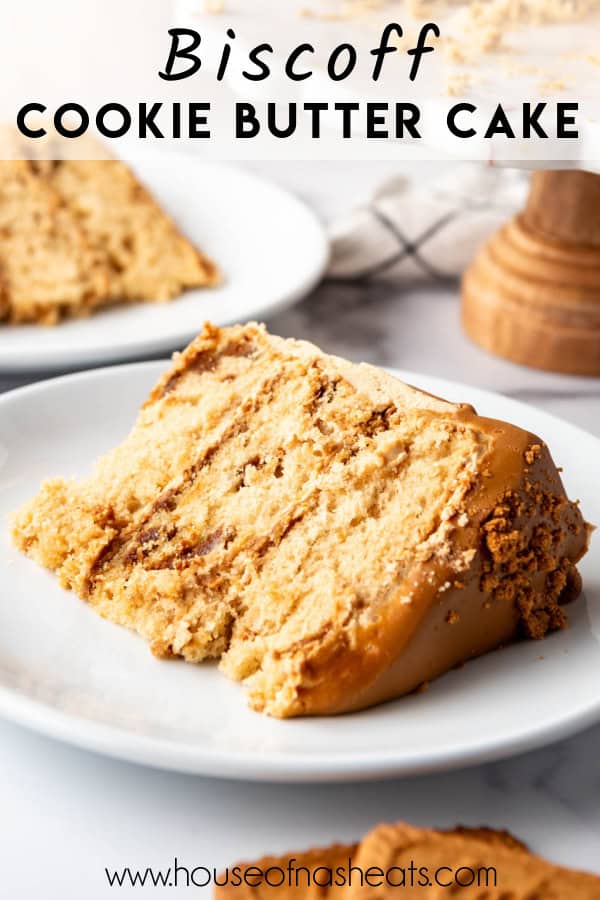

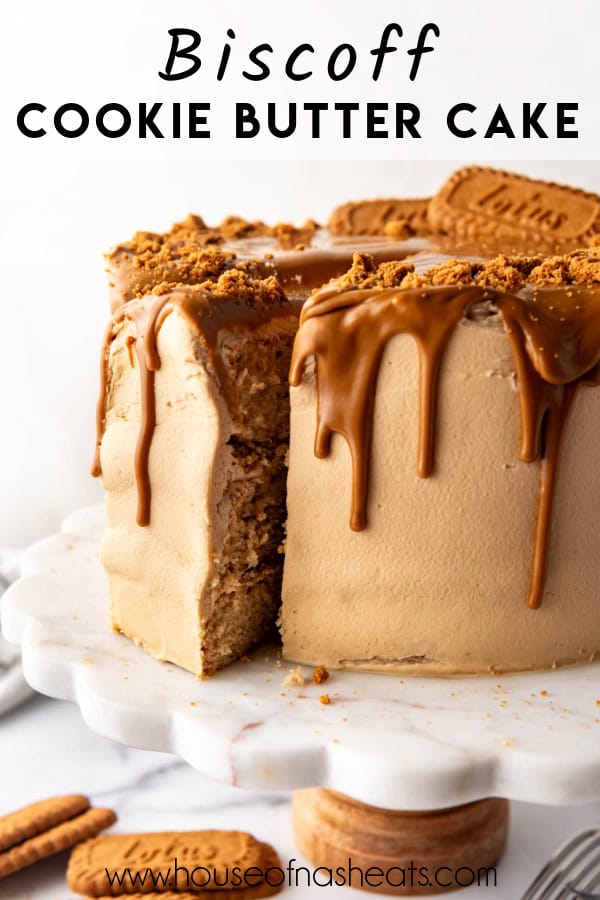
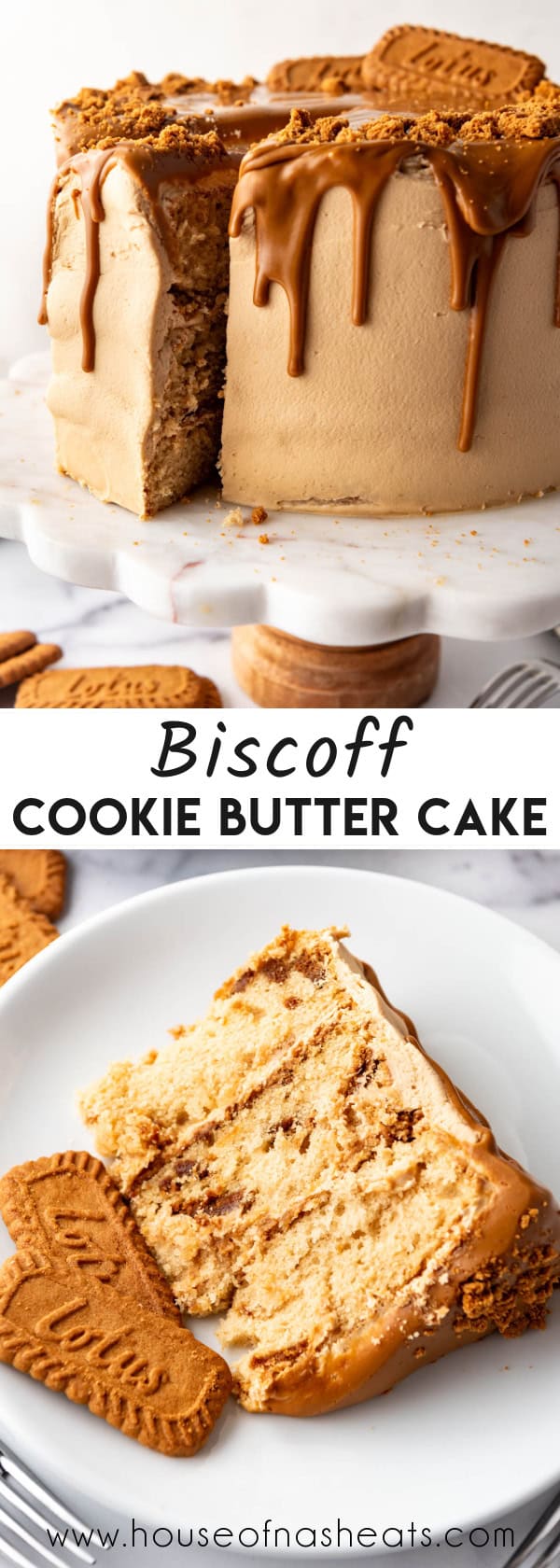
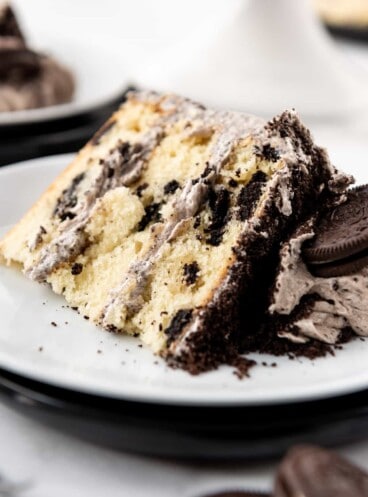
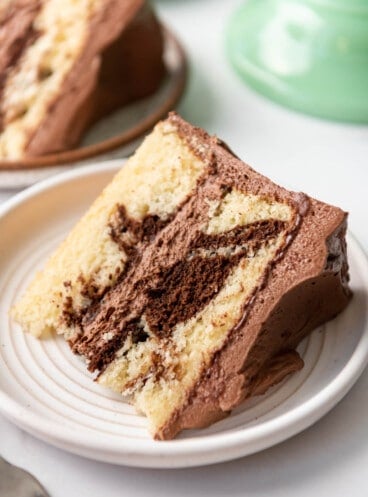
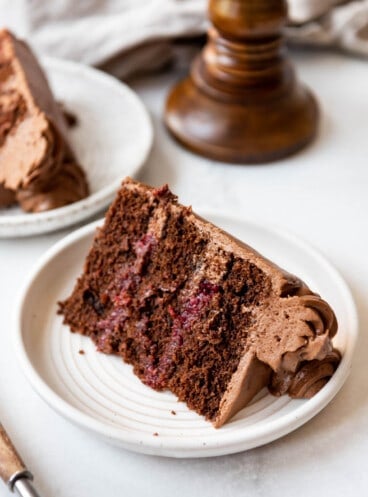

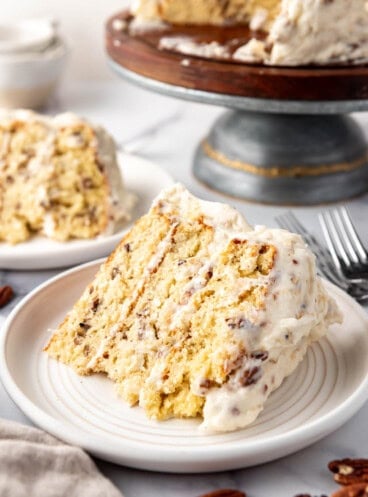
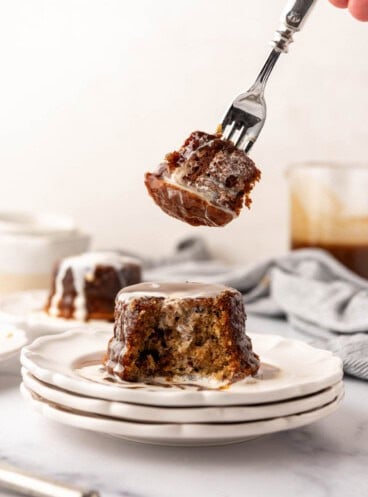
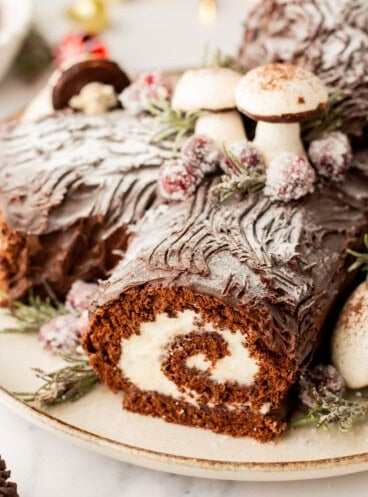
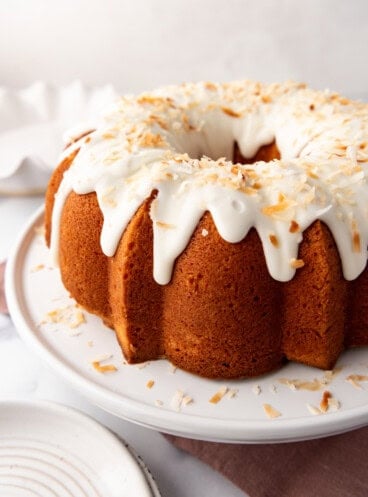
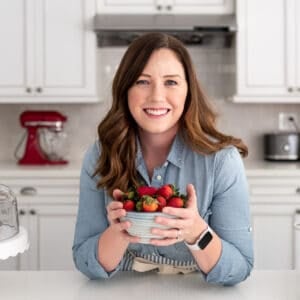
Biscoff Cake Recipe
What is cookie butter and where can I get it?
Cookie butter is a creamy spread made from finely ground Belgian speculoos spice cookies. It looks kind of like peanut butter or a nut butter. You can find it in most grocery stores!
I recently discovered that I really enjoy baking. I have baked several of your recipes and they are always a hit. I bake cakes to sell at the VFW during bingo. So far, they love all of the cakes I have made. I baked the cookie butter cake this past Friday. It was awesome!!!!
Wow! That is amazing! I love that you have discovered this new hobby! Thank you for making my recipes! I have some more cakes coming soon!
Thank you for the recipe. I loved the cake itself, it was super soft. My family did find it overall sweet with the cookie butter and buttercream in between the layers. I reduced the sugar in the buttercream by half and overall it was still quite sweet. I would love to be able to adapt the recipe to make it less sweet overall. I can’t wait to get a vanilla version of this sponge. Thank you for sharing.
Yes adapt it to how you like it! Everyone has different tastes! Thanks for making the cake!